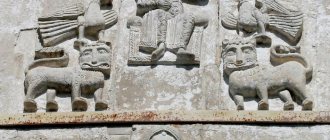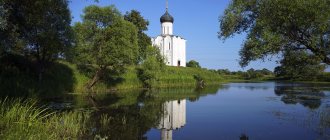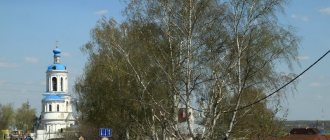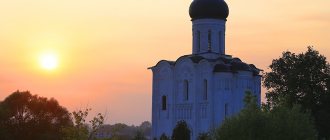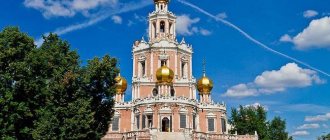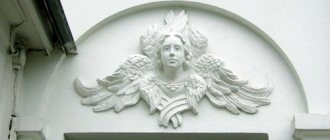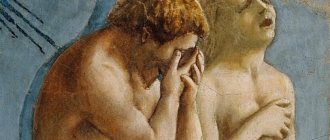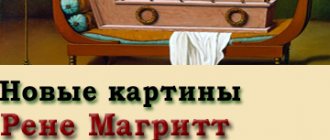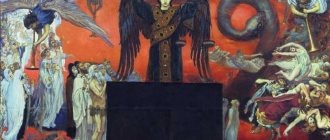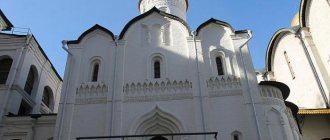The Church of the Intercession on the Nerl is an outstanding world monument of the Vladimir-Suzdal school, a masterpiece of ancient Russian white-stone architecture. The white stone church is located in a picturesque meadow at the place where the Nerl River flows into the Klyazma.
The Church of the Intercession on the Nerl is compared to a bride, called the pinnacle of creativity of Vladimir masters, a poem imprinted in stone, the most lyrical and unsurpassed masterpiece in all Russian architecture. This white stone temple blends surprisingly harmoniously with the surrounding landscape.
The dates of construction of the church vary in various sources. It is widely believed that the Church of the Intercession on the Nerl was built in 1165 by Prince Andrei Bogolyubsky in memory of his son who died during the campaign against the Bulgarian kingdom. The church is located in the Vladimir region, near the village of Bogolyubovo. They say that the place where the temple stands was chosen by Andrei Bogolyubsky himself. This church is considered the first in Rus' dedicated to the Feast of the Intercession of the Blessed Virgin Mary. The new holiday was established by Prince Andrei and the Vladimir clergy without the consent of the Kyiv Metropolitan and the Patriarch of Constantinople. This fact was intended to testify that the Vladimir land is under the special protection of the Mother of God.
The place where the church was built was not chosen by chance. At that time, the mouth of the Nerl River was a kind of shipping gateway to the Vladimir region. All the visiting merchants saw an amazing picture filled with harmony - a white stone temple towering above the river on a picturesque green meadow. Now the river has changed its course.
The temple's architectural design is extremely simple. This is a four-pillar, single-domed, three-apse cross-domed church typical of ancient Russian architecture. The Church of the Intercession on the Nerl is distinguished, noted by many specialists and researchers, by its overall harmony and sophistication of proportions; it looks weightless, as if floating in the air. A stunning picture can be seen in the spring, when the temple, like a burning candle, rises to the sky above the flooded waters of the Nerl.
See also:
- Church of the Ascension in Kolomenskoye
- St Basil's Church
The feeling of mobility and flight is given to the temple by the walls slightly inclined inward, which is almost imperceptible, as well as by striking vertical lines - tall narrow windows, elongated columns of the arcature belt. Such techniques visually increase the height of the building. The walls of the church are decorated with carved reliefs. In the composition of the three facades of the temple, the central figure is King David seated on the throne with a psalter in his left hand, blessing with two fingers with his right hand. Also used in the design are women's masks, birds, and lions.
View 360°
Aerial photo panorama from AirPano.ru
In 1992, the Church of the Intercession on the Nerl, together with eight other monuments of ancient Russian white-stone architecture (Assumption Cathedral, Demetrievsky Cathedral, Suzdal Kremlin, etc.), located in the Vladimir region, was included in the UNESCO World Heritage List under the general collective name “White stone monuments of Vladimir and Suzdal". All of them are also part of the Vladimir-Suzdal Museum-Reserve, formed in 1958. And the water meadow on which the church stands was declared a special protected natural area.
Vakhtanov S.N. The graffiti of the Church of the Intercession on the Nerl has until now remained beyond the special scientific interest of researchers of the architectural heritage of Vladimir-Suzdal Rus'. To this day, not only are there no publications specifically devoted to the study of medieval graffiti of the Church of the Intercession, but even brief mentions of this phenomenon in publications on the history and architecture of this wonderful temple. The only thing that is given in the literature is a large carved inscription: “St. David”, accompanying relief images of this biblical king, located on three facades in the central zakomari. Thus, the topic of graffiti and the Church of the Intercession on the Nerl is little studied. It should be noted that the study of the graffiti of the Church of the Intercession was carried out jointly with an employee of the Institute of Archives of the Russian Academy of Sciences, Doctor of Historical Sciences. A. A. Medyntseva, who took upon herself the work of reading, dating and subsequent publication of graffiti inscriptions. Ancient graffiti was found both inside the monument and on the outer sections of its walls. They are quite numerous and varied in topic. However, it is not possible to determine their exact number today, since many images are unclear, fragmentary, sometimes almost completely lost due to the destruction of the stone itself or hidden by a layer of plaster. In terms of their content, graffiti drawings correspond to three main groups, traditionally present on almost all monuments of Vladimir-Suzdal white stone architecture. These are images of a religious nature, everyday drawings and construction marks. The drawings of the first group are the most numerous. First of all, these are crosses. Moreover, it is necessary to note the observation that on the outside of the church in all the drawings identified to date (i.e., designs in which there is or is a meaning) there are exclusively crosses.
Il. 1. Crosses on the jamb of the northern portal: A - on the left side of the jamb, B - on the right side of the jamb
On the left side of the jamb of the northern portal there are fairly clear images of at least five crosses (Fig. 1A). Two of them (located on the second roller from the center of the portal) are carved into the stone quite deeply and have triangular extensions at the ends of the blades. True, for some reason the lower cross remained unfinished or was not completely preserved (only its vertical part is available). In their designs and the technique of applying them to stone, these crosses are similar to a similar graffiti cross from the Golden Gate of Vladimir, dated N.N. Voronin according to the inscription relating to him from the 12th-13th centuries, most likely from the 13th century. It can be assumed that these two crosses appeared during the same period. On the right side of the jamb of the northern portal, on the second bolster from the center of the portal, there is another barely noticeable small (about 4 cm) four-pointed cross on a single-stage Golgotha (ill. 1B).
Il. 2 Calvary cross with spurs on the left side of the jamb of the western portal.
On the bolsters and rectangular shelves of the western portal, several more crosses and their fragments can be seen. Among them, two small four-pointed crosses on the first and second bolsters, a Golgotha cross on the outer bolster of the right side of the jamb, as well as four crosses on the stones on the left side of the portal jamb are relatively clearly visible. One of these last ones looks a little peculiar. It is depicted standing on a high three-stage Calvary (ill. 2) - it has steeply curved spurs at its base, similar to the spurs of the 12th century cross. from the head of the Demetrius Cathedral in Vladimir (ill. 3 A).
Il. 3 A - Cross with spurs of the 12th century. from the head of the Demetrius Cathedral in Vladimir. B - Cross with spurs on the plinth at the turn of the 11th-12th centuries. Suzdal Cathedral.
We find the closest analogy of such spurs among graffiti in the Suzdal Cathedral - this is a cross with spurs on the plinth at the turn of the 11th-12th centuries. (ill. 3 B). The cross is framed by a figured frame in the form of an icon case. At the base of Golgotha there is a figure that looks like a small tree with three (possibly five) shoots.
Il. 4 A flourishing cross on the semi-column of the pilaster to the left of the western portal.
Another unusual cross (Fig. 4) is flourishing and is located on the second pilaster block from the plinth, located to the left of the western portal. In its design it is very reminiscent of a snowflake. In the interior of the temple, there is graffiti on the walls and pillars of the quadrangle, in the altar and on the choir.
Il. 5 Drawing of the temple on the eastern edge of the southwestern pillar.
There were seven of them in the altar, seven in the quadrangle, and eleven in the choir. Most often there are crosses of regular shape with a clear pattern. Among them, seven crosses are of the “Greek” cross type, and no less than six are Calvary crosses. This group of graffiti also includes an image of a one-domed temple with a mosquito cover (Fig. 5), located on the eastern edge of the southwestern pillar.
Il. 6 Crosses on the western edge of the northwestern pillar in the choir. Il. 7 The “Tree of Life” drawing on the southern edge of the northwestern pillar in the choir. Il. 8 A pattern with concentric circles on the central spindle of the western wall in the choir.
There are practically no signs to determine the exact date of the images of this group. Nevertheless, the range of analogies identified on other monuments of Vladimir-Suzdal Rus', which can be dated thanks to the inscriptions accompanying them, indicates the pre-Mongol origin of a number of designs of crosses with triangular extensions at the ends of the blades (these are three crosses on the northwestern pillar on the choir ( Fig. 6), two crosses on the southern edge of the pilaster of the northern wall, opposite this pillar under the choir, two crosses on the bolster of the left side of the jamb of the northern portal). The cross with spurs mentioned above should undoubtedly be attributed to the same period. Among the graffiti of the second group, an interesting drawing is the “Tree of Life” (Fig. 7), located on the southern edge of the northwestern pillar on the choir. It consists of a trunk tapering upward and two large symmetrically curved shoots. In the poorly preserved upper part of the “Tree,” fragments of small shoots are faintly visible. To the right of the central window of the western wall (on the choir) you can see a design scratched on the stone, consisting of concentric circles (Fig. 8).
Il. 9 Image of horses: A - on the blocks of the western spindle of the northern wall (under the choir), B - on the eastern edge of the south-eastern pillar.
In the quadrangle on the northern wall and western pillars there are drawings of at least eight horses, depicted both in groups and individually (ill. 9). Some have survived in fragments. The manner and technique of applying the design to the stone apparently indicate the authorship of one person. He also probably owns the inscription next to the drawing of several horses on the northern edge of the northwestern pillar (ill. 10).
Il. 10 Image of horses and inscription from the late 14th - early 15th centuries. on the northern edge of the northwestern pillar.
The inscription was dated A.A. Medyntseva late XIV - early XV centuries.
Il. 11 Construction mark on the north wall in the chancel of the church.
Graffiti of the third group are few in number. Only one construction mark was found in the form of a diagonal connecting the lower left and upper right corners of the front surface of the block on the northern wall in the altar of the church (Fig. 11). Thus, the graffiti of the Church of the Intercession on the Nerl demonstrates a tradition widespread in Ancient Rus'. Their semantic range is quite wide: from symbols with sacred meaning to construction marks. Even the most preliminary analysis of the themes of medieval graffiti in relation to their location in the architectural space of the temple allows us to draw a completely obvious conclusion using the example of white stone monuments of the Vladimir-Suzdal land. This is the conclusion that, firstly, as you approach the altar, as well as on the doorposts of the portals, the prayerful and sacred semantic orientation of the images increases; secondly, in the earliest buildings the percentage of use of construction marks by architects increases noticeably. Literature used: State Vladimir-Suzdal Historical, Architectural and Art Museum-Reserve “Research Materials” issue 17. 2011. Church of the Intercession on the Nerl. Graffiti from the Church of St. Boris and Gleb XII century. in the village of Kideksha Graffiti of the Golden Gate in Vladimir Graffiti of the Assumption Cathedral in the city of Vladimir
Copyright © 2021 Unconditional love
Church of the Intercession on the Nerl - PHOTO
Artist's painting
The story behind the creation of the masterpiece is as follows. The master painted the canvas in 1937. At this time, repression was rampant in the country; it was a rather turbulent time. Perhaps he wanted to find peace by working in such a blessed place. In those days, as mentioned above, churches and monasteries were closed, turned into warehouses or completely blown up. Fearing for this shrine, the artist captured it forever with the help of paints and canvas.
The white stone church is located in the central part of the exhibition, but it occupies a rather modest place. The beauty of a man-made creation does not overshadow the natural one. All objects on the canvas are harmoniously adjacent.
In the foreground we see the coastline. Against the background of green grass, yellow flowers stand out in bright, but not pretentious stripes. A woman and a child are walking here, the baby bent down to pick a spring flower.
Church architecture
In combination with the surrounding beauties, the temple seems to be an island of purity and grace of Russian architecture. Perhaps it was precisely for this beauty that S. V. Gerasimov painted “The Church of the Intercession on the Nerl”. Although if you look carefully, there is nothing special or pretentious in the temple. The building itself is simple, like many buildings of this type were at that time. It is a cross-domed temple on four pillars.
However, this is where the similarities with other similar structures end. The Church of the Intercession is very elegant, light and bright. All this cannot be found anywhere else. The architects tried to convey the aspiration upward, towards God. This was done by using some tricks in the construction (for example, many vertical lines, a barely noticeable inclination of the walls inward).
Initially, the temple was decorated with a helmet-shaped dome, but during reconstruction in 1803 it was replaced with an onion dome, which still stands today. The walls of the church are decorated with white stone carvings, which were traditional at that time.
The temple has three facades, each of which is decorated with an image of King David seated on a throne. On both sides there are a dove, and below are lions. Below the animals are masks of women whose hair is braided. These masks are a symbol of the Mother of God. They were very often depicted on temples of that era.
